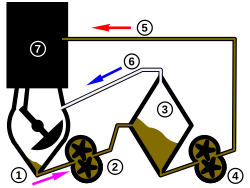
Back Trockensumpfschmierung German Cárter seco Spanish روغنکاری حوضچه خشک Persian Carter sec French ドライサンプ Japanese 드라이 섬프 Korean Dry-sumpsysteem Dutch Tørrsumpsmøring NB Torrsumpsmörjning Swedish Система мащення із сухим картером Ukrainian
This article needs additional citations for verification. (December 2010) |

A dry-sump system is a method to manage the lubricating motor oil in four-stroke and large two-stroke piston driven internal combustion engines. The dry-sump system uses two or more oil pumps and a separate oil reservoir, as opposed to a conventional wet-sump system, which uses only the main sump (U.S.: oil pan) below the engine and a single pump. A dry-sump engine requires a pressure relief valve to regulate negative pressure inside the engine, so internal seals are not inverted.
Dry-sumps are common on larger diesel engines such as those used in ships, as well as gasoline engines used in racing cars, aerobatic aircraft, high-performance personal watercraft and motorcycles. Dry sump lubrication may be chosen for these applications due to increased reliability, oil capacity, reduction of oil starvation under high g-loads and/or other technical or performance reasons. Dry sump systems may not be suitable for all applications due to increased cost, complexity, and/or bulk, among other factors.
© MMXXIII Rich X Search. We shall prevail. All rights reserved. Rich X Search